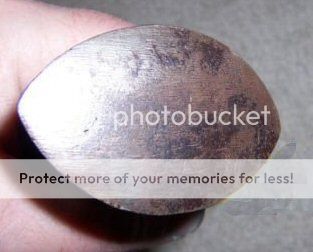I wonder if anyone can shed any light on this giant khukuri that I acquired recently. From its size and weight I can't see it having any practical use except perhaps for decapitations.
It is 25" long, weighs 42 oz, and has an elaborately engraved steel handle. The blade and handle have the same general shape as one of those Longleaf vintage khukuris from the late 1800s or early 1900s, except for the large size and the prominent steel ring on the handle.
All this is clearly seen in the photos. The wide fuller on each side of the blade is quite deep, but doesn't show very well in the photos because of the width. (You can see it best in the last photo below.) I've handled many khukuris and can attest that this one is very well made. The blade shows tiny nicks along its edge and very small pitting on the sides. Both blade and handle have a nice grayish patina that does show up in the photos. The pommel is also steel and is one piece with the handle.
The spine thickness is 7/16" from the bolster all the way to the bend, and from there tapers gradually toward the tip. The edge profile is fairly narrow, but I haven't measured the angle. There's still a lot of "meat" behind the edge, but this isn't designed as a heavy chopper.
The handle is very comfortable except for the exaggerated steel ring. At first it seemed that the ring would tear up the hand of anyone who didn't wear heavy gloves. Interestingly, I've discovered that the more I hold this blade the more my hand finds a way to shape itself around the ring, so now I can see someone using it without gloves, though it would be a strain. Anyway, a blade of this size and weight is hardly suited to chopping wood, hence my belief that it was intended for some kind of ritual work, or perhaps just as "functional art."
I've been unable to estimate the age of this thing. The patina seems to be natural and the design traditional. The handle is clearly high end, and the blade is very graceful, even the way the edge curves around toward the cho. The shaping and engraving of the handle must have required some sophisticated techniques, or perhaps modern machinery. Even if it was done by machine, someone put a lot of time and effort into it.
Here are some photos. In the full-length photo I show it next to my 29" HI Tarwar by Lokendra kami, for size comparison. The blade has no maker's mark, so I added that to the photo as well. Enjoy:





It is 25" long, weighs 42 oz, and has an elaborately engraved steel handle. The blade and handle have the same general shape as one of those Longleaf vintage khukuris from the late 1800s or early 1900s, except for the large size and the prominent steel ring on the handle.
All this is clearly seen in the photos. The wide fuller on each side of the blade is quite deep, but doesn't show very well in the photos because of the width. (You can see it best in the last photo below.) I've handled many khukuris and can attest that this one is very well made. The blade shows tiny nicks along its edge and very small pitting on the sides. Both blade and handle have a nice grayish patina that does show up in the photos. The pommel is also steel and is one piece with the handle.
The spine thickness is 7/16" from the bolster all the way to the bend, and from there tapers gradually toward the tip. The edge profile is fairly narrow, but I haven't measured the angle. There's still a lot of "meat" behind the edge, but this isn't designed as a heavy chopper.
The handle is very comfortable except for the exaggerated steel ring. At first it seemed that the ring would tear up the hand of anyone who didn't wear heavy gloves. Interestingly, I've discovered that the more I hold this blade the more my hand finds a way to shape itself around the ring, so now I can see someone using it without gloves, though it would be a strain. Anyway, a blade of this size and weight is hardly suited to chopping wood, hence my belief that it was intended for some kind of ritual work, or perhaps just as "functional art."
I've been unable to estimate the age of this thing. The patina seems to be natural and the design traditional. The handle is clearly high end, and the blade is very graceful, even the way the edge curves around toward the cho. The shaping and engraving of the handle must have required some sophisticated techniques, or perhaps modern machinery. Even if it was done by machine, someone put a lot of time and effort into it.
Here are some photos. In the full-length photo I show it next to my 29" HI Tarwar by Lokendra kami, for size comparison. The blade has no maker's mark, so I added that to the photo as well. Enjoy:





Last edited:
